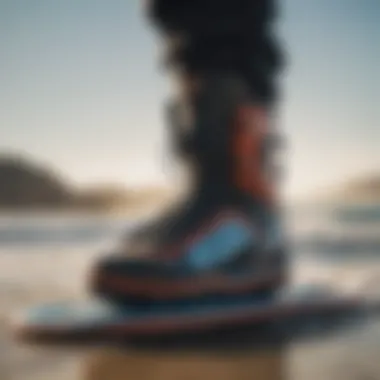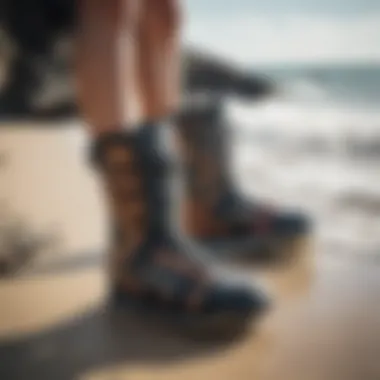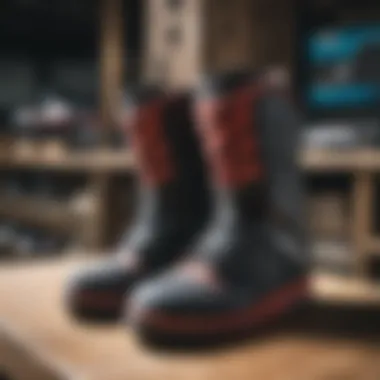Kiteboard Boots: A Comprehensive Guide for Enthusiasts


Intro
Kiteboarding is a thrilling blend of adventure and strategy, and the right gear can make or break your experience on the water. At the heart of that gear, kiteboard boots play a pivotal role, influencing not just comfort, but also the overall performance of the kiteboarder.
Why Kiteboard Boots Matter
Choosing the right boots is crucial. They provide connection between the rider and the kiteboard, allowing for better maneuverability and control. With advancements in materials and design, modern kiteboard boots are tailored for various conditions and skill levels. Whether you are just dabbling your toes in this sport or you are a seasoned rider, understanding the nuances of kiteboard boots can greatly enhance your kiting experience.
Many newcomers might not realize that the boots affect how they catch air, land tricks, or even how much fatigue they feel by the end of a long day on the water. These factors play into the overall enjoyment and performance, creating an experience that should not be underestimated.
In this comprehensive look into kiteboard boots, we’ll unpack their design, functionality, and the many considerations that enthusiasts must keep in mind.
Gear Insights
When it comes to gear in kiteboarding, having the right boots can be the difference between a enjoyable day on the waves and a frustrating one. Let's dive into the latest developments and fundamental recommendations.
Latest Gear Reviews
Recent years have seen notable strides in the technology behind kiteboard boots. Brands like North Kiteboarding and Slingshot have introduced models that cater to both performance enthusiasts and recreational riders.
- North Kiteboarding Elite: Known for its lightweight design and snug fit, ideal for advanced riders aiming for maximum responsiveness.
- Slingshot Shredtown: This boot promotes comfort while providing adequate support, making it an excellent choice for beginners and casual riders.
"The right pair of boots can do wonders for your skills; it’s not just about style but functionality that elevates your game."
Essential Gear for Beginners
If you're just stepping into the realm of kiteboarding, don't skimp on your choice of boots. Comfortable and well-fitting boots can accelerate your learning curve. Consider these factors:
- Size and Fit: Ideally, the boot should fit snugly to ensure effective energy transfer without pinching.
- Flexibility: Look for boots that allow a good range of motion, especially when executing turns or jumps.
- Durability: Given that kiteboarding equipment often faces sandy and salty conditions, opt for boots made from high-quality materials that withstand wear and tear.
Techniques and Tips
Having solid gear is pivotal, but equally important is perfecting your technique and adhering to best safety practices.
Advanced Tricks and Techniques
For experienced riders looking to up their game, focus on:
- Executing controlled pop-offs the water’s surface.
- Incorporating spins and flips into your runs for a more dynamic performance.
Spend time mastering board control; it’s fundamental for performing complex tricks.
Safety Practices for Kiteboarders
Regardless of skill level, safety should always be a priority. Here are some essential practices:
- Pre-Flight Checks: Always check your equipment before heading out. Ensure your boots and straps are free from damage and wear.
- Weather Knowledge: Understand the wind and water conditions to avoid putting yourself at risk.
In the end, kiteboarding is about enjoying the thrill of the ride. Equip yourself with the right knowledge and gear to make the most of each session.
Preface to Kiteboard Boots
Kiteboarding, a sport that blends the exhilarating rush of wind and water, hinges significantly on the gear used, particularly the boots. Kiteboard boots serve not only as a connection between the rider and the board but also play a pivotal role in enhancing overall performance and safety. Understanding the nuances of these boots is critical for anyone looking to sharpen their skills on the water.
Boots act as your trusty companions out there, giving you the grip and control necessary to maneuver with confidence. With the right boots, you'll find that control over your board becomes as natural as breathing. However, it's not just about comfort; choosing the wrong type can lead to discomfort or worse, injuries. The selection of kiteboard boots is thus an integral part of the kiteboarding experience, directly influencing how well you ride.
Understanding the Role of Kiteboard Boots
Kiteboard boots fulfill several key functions. First and foremost, they anchor your feet to the board, enabling you to exert force for jumps and turns without slipping off. This connection between board and rider is essential for executing tricks and maintaining stability during high-speed rides.
Additionally, the design of the boots can significantly impact your overall performance. For instance, some boots offer a more rigid structure, providing enhanced support, while others might focus on flexibility, allowing for greater movement. Riders often find that boots with superior arch support can reduce fatigue, allowing for extended periods on the water.
In essence, kiteboard boots are pivotal for:
- Safety: A proper fit reduces the risk of injuries.
- Control: They enhance your ability to steer and perform tricks.
- Comfort: Quality construction can mean the difference between a fun outing or a painful experience.
History and Evolution of Kiteboard Boots
Kiteboarding, although relatively new compared to other sports, has witnessed a rapid evolution in gear, particularly in boot design. In the early days, riders often used standard wakeboarding boots, which provided some connection but lacked the finesse tailored specifically for the needs of kiteboarding.
As the sport grew, manufacturers recognized the need for a more specialized boot. The introduction of flex zones, improved lacing systems, and customizable support marked significant advancements. For example, early bindings were often cumbersome and lacked adjustability, making it tough for riders to find the right fit. Over time, companies started to innovate, focusing on lightweight materials and ergonomic designs.
Each iteration of boot design has pushed the limits of performance, with materials becoming more durable and water-resistant, while design philosophies shifted toward maximizing rider control and comfort. Understanding this history not only enlightens us about the sport's evolution but also highlights how technology continues to shape kiteboarding gear.


In summary, the journey of kiteboard boots reflects a commitment to enhancing rider experience. By grasping their role and evolution, both new and seasoned riders can make informed decisions that heighten their enjoyment and success on the water.
Types of Kiteboard Boots
Understanding the different types of kiteboard boots is essential for both novice and seasoned kiteboarders. The right boots can significantly influence your performance on the water, shaping not only the way you ride but also how you interact with your board and the elements. As you dive into the world of kiteboarding, knowing your options is crucial for making a well-informed choice that balances comfort, control, and support.
Strap-in Boots
Strap-in boots are one of the most common types found in kiteboarding. They offer a good balance of comfort and security, and they are generally easier to put on and take off. These boots feature adjustable straps that wrap around the foot and ankle, providing a snug fit that keeps you connected to the board without being overly restrictive.
The design of strap-in boots tends to be versatile, making them suitable for a variety of riding styles. Whether you’re performing tricks or enjoying a leisurely ride, they allow for decent flexibility and movement. Additionally, strap-in boots are often lighter than other types, meaning less fatigue during long sessions on the water.
Benefits of strap-in boots include:
- Ease of use: Quick entry and exit, perfect for those who want to paddle out and get riding.
- Adaptability: Suitable for all skill levels and various riding styles.
- Comfort: Soft materials often used in the design enhance the riding experience.
However, some riders find that strap-in boots can lack the solid connection of hard boots, which might be a disadvantage for more aggressive riding.
Fixed Bindings
Fixed bindings create a rigid connection between the rider and the board. In essence, these bindings do not allow for any movement independent of the board, which can provide unparalleled performance in terms of control. Riders who favor aggressive maneuvers or plan to do competitive kiting often lean toward fixed bindings for their performance benefits.
These bindings usually feature a more robust construction, designed to withstand the rigors of high-intensity riding. This rigidity can lead to improved responsiveness when executing tricks, jumps, or navigating choppy waters.
Key points about fixed bindings include:
- Increased control: The solid attachment aids in performing high-level maneuvers.
- Stability: Helps maintain balance, especially in unpredictable conditions.
- Durability: Often built to last through rough sessions.
On the flip side, the inflexibility of fixed bindings can prove uncomfortable for some, especially during prolonged use. Riders might find them constricting, which could affect their overall riding experience.
Booties vs. Hard Boots
When weighing the options between booties and hard boots, it’s essential to understand the context of your kiteboarding activities. Booties, typically made of thick neoprene, offer a comfortable and flexible fitting, enabling ease of movement while still keeping feet warm in colder water. They are particularly appealing for those who prefer a less restrictive option or ride in varying water temperatures.
On the other hand, hard boots are akin to skiing boots, providing maximum support and stability. They connect your foot to the board firmly, allowing for precision control and effective energy transfer. However, the trade-off is that they can be heavier and less forgiving in terms of comfort compared to booties.
Considerations for choosing between booties and hard boots:
- Flexibility: Booties provide comfort; hard boots enhance control.
- Water conditions: Warm vs cold water can dictate your choice.
- Riding style: Your approach to kiteboarding should influence your decision.
Ultimately, the decision between booties and hard boots should be grounded in personal preference and the specific riding conditions you expect to encounter.
"The right boots can elevate your kiteboarding experience — choosing is as important as the board itself."
By understanding the nuances of strap-in boots, fixed bindings, and the booties versus hard boots debate, you’ll be better equipped to select the right gear to enhance your kiteboarding escapades.
Key Features to Consider
When it comes to choosing the right kiteboard boots, understanding what to look for can significantly influence your performance on the water. Kiteboarding, while exhilarating, demands precision and comfort to reach its full potential. The right pair of boots doesn’t just keep your feet secure; it also enhances your overall control and responsiveness while riding. With numerous models flooded in the market, knowing which features matter is vital for both safety and enjoyment.
Material Composition
The material your boots are made of can impact everything from durability to comfort. Most kiteboard boots are crafted from synthetic materials that can withstand harsh environments. Rubber soles are common, providing grip when you step on the board. However, not all rubbers are created equal. Some newer materials, like thermoplastic urethane (TPU) or neoprene, offer a balance between flexibility and support. These materials can also provide insulation from cold water, adding to your comfort during those brisk kiteboarding sessions.
Consider that the construction quality can also dictate how well the boot performs under pressure. For instance, double-stitched seams in high-stress areas can enhance durability.
Wear and tear from the elements can lead to decreased performance over time, so selecting a boot with high-quality materials helps ensure longevity—a worthy investment for any kiteboarder.
Size and Fit
Getting the right fit is non-negotiable when it comes to kiteboard boots. A snug fit ensures your feet won’t move around inside the boot while you're riding, enhancing your control. Many brands offer detailed sizing charts, and some even provide models in half sizes, catering to those of us whose feet fall somewhere in between.
A common misunderstanding is that a tight boot is always a good boot. If your boots pinch or squeeze, you may face discomfort and even reduced blood circulation, which isn’t going to help anyone. It's also important to remember that different brands might have different sizing policies, so trying them on, if possible, is a smart move.
In addition, some boots include adjustable straps or closures that allow for a customized fit. This means that as you progress in your skills (or in the number of sandwiches you consume), your boots can adapt to your needs.
Flex and Support Levels
Boot flexibility plays a crucial role in your riding style and comfort level. Rigid boots provide excellent support for high-impact riding and tricks, allowing you to engage with your board confidently. On the other hand, softer boots allow for greater flexibility and comfort, which is particularly appealing for beginners who prioritize ease of movement over extreme performance.
It's important to match the flex level to your riding style. For instance, if you're keen on jumping, you might favor stiffer boots for maximum energy transfer. If you’re more about cruising the waves, a flexible boot that absorbs shocks could be just the ticket.
"Choosing the right boot is more than just a purchase; it’s an essential decision that affects your performance and enjoyment in kiteboarding."
Performance Impact


The performance of kiteboard boots is a pivotal aspect of the kiteboarding experience that goes far beyond just comfort. These boots act as the essential link between the rider and the board, shaping how one maneuvers on water. Several factors contribute to the substantial impact that boots can have on riding efficiency, control, and overall performance.
How Boots Enhance Control
First and foremost, boots are designed to provide optimal control over the board. A good pair of boots enables the rider to have a firm grip and feel of the board beneath their feet, which can significantly affect their handling during maneuvers. With features like adjustable straps and varying flex levels, riders can customize their setup to match their specific preferences.
- Grip and Traction: Boots with better grip allow for more precise foot placement. This is especially crucial during jumps or when attempting more advanced tricks. Whether you're cutting through water or hovering in the air, having reliable traction ensures that you stay connected to your board.
- Movement Flexibility: Depending on the boot design, some provide a stiffer feel for performance-focused riders, while others allow more flexibility for those who thrive on tricks and freestyle styles. Selecting the right stiffness can enhance how much control you have in different riding conditions.
- Foot Positioning: The right boot helps in maintaining optimal foot positioning, thus reducing the chances of premature fatigue or mishaps as you navigate waves or gusts of wind. Utilising boots that allow for proper alignment allows the rider to perform complex maneuvers with improved stability.
In essence, when boots are tailored to the rider's style and preferences, they can massively contribute to elevated control on the water.
The Relationship Between Boot Design and Riding Styles
Boot design is not a one-size-fits-all situation; it has a profound relationship with different riding styles. Understanding this connection ensures that riders choose their boots wisely based on how they intend to ride.
- Freestyle/Kiteboarding: Riders who often engage in trick-laden freestyle kiteboarding need boots that offer flexibility and support simultaneously. This type typically favors softer materials that can absorb shocks and allow for quick movements.
- Freeride: For freeriders, the focus shifts to control and stability. Boots designed for this style usually incorporate a stiffer build which helps in dealing with higher speeds and choppy waters, providing essential support without sacrificing performance.
- Waves and Surf: Wave riders benefit from boots that secure their feet firmly, usually opting for designs that prevent any wiggle or movement within the boot. A snug fit coupled with enough flex can assist in navigating the complexities of waves.
The right footwear is more than a piece of gear; it’s the foundation that can elevate your kiteboarding experience to new heights.
Maintenance and Care for Kiteboard Boots
Keeping your kiteboard boots in tip-top shape is essential not just for performance but also for safety. Kiteboarding often pits your gear against saltwater, sand, and sun—some of the harshest enemies of equipment longevity. A little bit of care can go a long way in maintaining both the aesthetics and functionality of your boots. In this section, we explore effective maintenance strategies to safeguard your investment and enhance your overall riding experience.
Regular Cleaning Protocols
When it comes to cleaning, consistency is key. After every session, you should rinse your boots with fresh water to remove salt and debris. This practice is a simple yet powerful habit that can prevent corrosion and mold growth. Here’s a step-by-step approach:
- Immediate Rinse: Right after you're done kiteboarding, give your boots a good rinse in fresh water. Be sure to focus on the inner lining where dirt can accumulate easily.
- Gentle Scrubbing: Use a soft brush or cloth to scrub off any stuck-on sand or salt build-up. Avoid abrasive materials that can scrape the surface.
- Drying: Let them air dry. Always remove the footbeds to ensure they dry thoroughly. Sticking them in direct sunlight can lead to material degradation, so find a shaded area.
- Periodic Deep Cleaning: Every few weeks, consider a deeper clean. Soak the boots in warm water mixed with mild soap for about 15 minutes, then rinse thoroughly and dry.
Doing these cleaning rituals can prevent odors and maintain the structure of the boot over time.
Storage Tips to Prolong Lifespan
Proper storage is a game changer when it comes to prolonging the life of your kiteboard boots. Here are some strategies to keep in mind:
- Keep Them Dry: Moisture can wreak havoc on your gear. Make sure your boots are completely dry before putting them away.
- Avoid Heat Sources: Never leave your boots near heaters or in a hot car. Excessive heat can warp materials and break down adhesives, leading to premature wear.
- Use a Protective Bag: If you have a designated bag for your kite gear, invest in it. Store your boots in a breathable bag that allows some airflow, preventing any potential mold or mildew.
- Store Upright: Whenever possible, store your boots upright or in a way that maintains their shape. Flat storage can lead to creasing which might not only look bad but also affect performance.
"Good maintenance is the bridge between performance and durability. The better you care for your gear, the more it rewards you on the water."
By prioritizing these maintenance and care techniques, you can ensure that your boots remain in excellent condition. This effort pays off, resulting in a more enjoyable and safer kiteboarding experience.
Technological Advancements in Kiteboard Boots
In the fast-paced world of kiteboarding, kiteboard boots have undergone significant transformations, driven by emerging technologies designed to enhance performance. Staying on top of these advancements is not just about having up-to-date gear—it's about optimizing your ride. Understanding the latest developments helps you choose boots that align with your skills and riding style, ultimately enriching your kitesurfing experience.
Smart Boots and Integration with Gear
The introduction of smart boots has paved the way for a new era in kiteboarding. These boots are often fitted with sensors that can measure a variety of metrics—like board speed, angle of attack, and even the pressure you apply on your feet. Imagine receiving live feedback on your riding performance during a session. This data can then be analyzed later, allowing you to pinpoint areas for improvement.
For instance, brands like North and Liquid Force offer models equipped with electronic components that sync up with mobile apps. These apps can deliver actionable insights right to your smartphone or smartwatch, making it easier to track progress over time. The practicality here lies in how it connects riders to their equipment, allowing a more informed riding style that is harmonious with technology.
Eco-Friendly Materials and Their Benefits
Sustainability is no longer a side topic; it’s at the forefront of many discussions around products and materials, and kiteboard boots are no exception. Manufacturers are increasingly adopting eco-friendly materials, such as recycled plastics and natural rubber, which significantly reduces the carbon footprint of their products.
One compelling example is the incorporation of bio-based materials. These materials are derived from renewable sources, aiming to preserve resources while also enhancing performance. Boots made with such materials not only respect the environment, but they often boast unique properties like enhanced durability and increased flexibility.
Additionally, using eco-conscious materials doesn't mean sacrificing performance. Many riders report that eco-friendly boots can offer as much, if not more, comfort and grip compared to their traditional counterparts. In the long haul, an informed choice leads to a dual benefit: a better riding experience for you and a more sustainable option for the planet.
"Riders today demand more than performance; they are looking for options that reflect their values and commitment to the environment."
As technology evolves, it's clear that kiteboard boots are not just being manufactured; they are being crafted for the future—where performance meets responsibility.
Choosing the Right Boots for Your Skill Level
When it comes to kiteboarding, selecting the appropriate boots to match your skill level is paramount. Not only does this decision influence your performance on the water, but it directly affects your level of comfort and safety during each session. A wrong choice could lead to frustrations, tiring experiences or a mishap that could easily have been avoided. Hence, understanding what boots to buy for where you stand in your kiteboarding journey is rocket science for the savvy rider.
Beginner Considerations
For those who are just starting out, comfort should sit pretty high on your list of priorities. Newbies often don’t have a firm grasp of the intricacies of kiteboarding, and that makes it easier to feel overwhelmed. Therefore, look for boots that offer ample cushioning and are easy to get in and out of.
- Strap-in Designs: These are user-friendly, allowing for an easier entry and exit, which is essential when you're still getting your sea legs.
- Adjustability: Features like Velcro straps or adjustable padding can greatly enhance comfort.
- Flexibility: A more forgiving boot can help prevent ankle soreness, making it easier to stay out longer.
Moreover, consider boots that have a solid grip. This helps to maintain stability on the board, providing a sense of security. As the saying goes, "Don't put all your eggs in one basket," don’t be overly tempted by flash over function, especially when you’re still mastering the basics.


Intermediate and Advanced Kiter Recommendations
As your skills advance, so should your choice of equipment. Experienced kiteboarders typically seek performance-enhancing features in their boots. What might have seemed sufficient as a beginner will likely feel like a drawback later on. Intermediate and advanced riders need boots that empower them to push their limits and master more complex maneuvers.
- Performance Fit: Look for a snug fit that minimizes foot movement within the boot, which enhances control.
- Stiffness: Advanced riders might benefit from stiffer boots that provide greater support for high-speed maneuvers and jumps.
- Material Technology: Advanced materials can offer better waterproofing, durability, and lightweight properties, crucial for those long-distance rides.
- Types of Boots: Whether you opt for hard boots or soft models, the choice should align with your riding style—casual free riding versus aggressive performance-focused techniques.
As you dive deeper into the kiteboarding realm, investing in a pair that meets your skill set becomes more than just footwear; it’s about enhancing your experience. As with anything else, balance is key. You want boots that provide all the right features without making your feet feel like they’re in a vice.
Each stage of your kiteboarding journey presents unique needs and priorities worth considering. Paying attention to your evolving skills and matching them with the right boot selection can make all the difference and foster not just better performance but also significant growth in your ability to ride passionately and fearlessly.
Proper boot selection allows for progression, adding and sharpening your skills as you grow as a rider.
Top Brands in Kiteboard Boots
When it comes to kiteboarding, the brand of boots you choose can significantly shape your riding experience. There’s a broad spectrum of options available, and some brands have carved out a niche as leaders in the field – owing to their commitment to quality, technology, and rider feedback. The importance of top brands in kiteboard boots lies in how they manage to combine innovative design with practical functionality, ensuring that your time on the water is not only enjoyable but also safe.
Selecting boots from reputed manufacturers usually suggests reliability and performance. High-quality boots can mean the difference between a snap decision mid-jump and executing that perfect trick you’ve been practicing. Let’s take a closer look at some of the most respected names in the biz and see what they bring to the table.
Leading Manufacturers and Their Offerings
Here, we uncover a spectrum of leading manufacturers in kiteboard boots. Each one boasts unique products that cater to various riding styles and skill levels:
- North Kiteboarding – Known for their premium craftsmanship and style, North offers boots that feature a snug fit and excellent control, ideal for both freestyle and freeride enthusiasts. Their design philosophy emphasizes durability and comfort, making them a go-to choice for many.
- Cabrinha – With a strong reputation in the kiting community, Cabrinha produces boots that provide enhanced support and responsiveness. Their featured models often include adjustable features that allow riders to easily customize fit, which is especially beneficial for high-performance riding.
- Duotone – This brand stands out for its innovative use of materials and significant focus on rider feedback. Duotone’s boots are well-regarded for their innovative designs that maintain a balance of flexibility and support, accommodating various driven riding styles.
- Liquid Force – With roots that extend back to the heart of wakeboarding, Liquid Force has made a splash in the kiteboarding industry. Their boots often incorporate wider footbeds and enhanced grip, making them an excellent choice for those who prioritize stability on the water.
This diverse assembly of brands provides kiteboarders ample choices to suit their individual needs, directly influencing overall performance.
Comparative Reviews of Popular Models
In a sea of options, choosing the right model can be a daunting task. Here’s a closer look at a few popular boots from mentioned brands, analyzing their features, strengths, and weaknesses:
- North Kiteboarding Team 6
- Cabrinha O
- Duotone Entity
- Liquid Force Legion
- Pros: Great for freestyle, offers excellent control and grip.
- Cons: May be too rigid for those who prefer a softer feel.
- Pros: Versatile adjustable features, perfect for various conditions.
- Cons: Heavier than some competing models, which could affect performance in lighter winds.
- Pros: Stylish design, lightweight with a snug fit.
- Cons: The snug fit could be uncomfortable for riders with wider feet.
- Pros: Incredible stability, superior foot support.
- Cons: Might feel too bulky for some riders pushing for agility.
These models showcase each brand’s approach to creating functional and stylish kiteboard boots. Riders must carefully assess their preferences and conditions while considering a purchase from their favourite brands.
In the end, picking the right brand is not just about popularity; it’s about what feels right for you as a rider. The balance of features, comfort, and style ultimately culminates in an enjoyable kiteboarding experience.
User Experiences and Reviews
When it comes to kiteboard boots, tapping into user experiences and reviews offers a treasure trove of insights that go beyond mere specifications and brand claims. This section underscores the significance of real-world feedback from kiteboarders who have put these products to the test in diverse conditions. Understanding this type of experiential knowledge helps prospective buyers make informed decisions, especially since kiteboarding equipment can vary immensely in performance and comfort.
Community Feedback and Common Concerns
In the vibrant world of kiteboarding, the community thrives on shared experiences. Online forums and local meet-ups serve as platforms for kiteboarders to voice their thoughts on different brands and models of boots. Engaging with this feedback can reveal common concerns, such as fit issues, durability, and whether the boots perform well under various weather conditions.
- Fit and Comfort: Many users emphasize the importance of fit. A common piece of advice is to ensure the boots don’t just feel good during a quick try-on but are also comfortable during extended periods on the water. This can significantly affect a rider's performance.
- Durability Under Stress: Another frequent subject of concern is how well boots hold up after continual use. Detailed reviews often include specific examples where boots either lived up to the hype or fell short due to wear and tear.
- Versatility: Many experienced kiteboarders highlight the versatility of certain models. They often discuss whether a particular boot can handle a range of conditions, from light winds to more turbulent waters. This insight is invaluable for newcomers trying to make sense of what they might need.
"I’ve found that talking to others about their experiences is just as valuable as testing boots myself. You never know what kind of hidden flaws or diamonds you might find out there!"
— A seasoned kiteboarder
Real-World Performance Reports
Nothing matches the insights derived from real-world performance reports. Kiteboard boots are not just one-size-fits-all products; their performance varies based on rider skill, style, and the specific situations in which they are used. Here’s what real users typically focus on when discussing their experiences:
- Performance in Different Conditions: Riders share their insights into how certain boots handle various weather conditions. For example, a pair of boots that excels in calm winds might struggle when thrown into the choppy waters of a storm, leading to a significant performance dip.
- Impact on Riding Styles: Reviews often dive into how boots affect different riding styles—be it freestyle, wave riding, or backcountry explorations. A freestyle rider might rave about a boot's flexibility, while a wave rider may prioritize support and stiffness. Readers can thus correlate their riding preference with boots that others have found successful.
- Pro Performance: Some reviews come from professional kiteboarders, adding an elite perspective on how certain models stand up to rigorous use. These reports can provide valuable insights into the build quality and technical specifications that other users may not always notice.
In sum, diving deep into user experiences and reviews not only highlights the practical aspects of kiteboard boots but also paints a fuller picture of how they fare in real-world conditions. This section aims to arm prospective buyers with the knowledge that can only come from those who have been there, done that. By incorporating community wisdom, this guide not only elevates your purchasing journey but also fosters a sense of camaraderie among kiteboarders at every skill level.
Culmination and Recommendations
In the realm of kiteboarding, the selection of boots plays a crucial role in not only performance but also in the overall enjoyment of the sport. Choosing the right pair can make the difference between soaring smoothly above the waves and struggling just to keep your feet attached to the board. Kiteboard boots are more than just accessories; they are integral to your capability to control the kite as well as your movements on the water.
Summarizing Key Insights
The journey through the various elements of kiteboard boots reveals essential insights that should guide every kiter in their purchasing decisions. Here are some highlights:
- Types of Boots: Understanding the difference between strap-in boots and hard boots, along with booties, helps to tailor choices to different riding styles.
- Material Composition: The choice of materials affects weight, durability, and responsiveness, making it a critical consideration.
- Fit and Comfort: A proper fit is absolutely paramount, ensuring both comfort and control. Boots shouldn’t just feel snug; they should conform to the foot's shape without causing discomfort.
- Flexibility and Support: Different riding styles require different flex levels, which profoundly impacts maneuverability versus support.
- Maintenance Matters: A few moments spent on cleaning and storage can prolong the life of your boots, saving you money in the long run.
More importantly, user feedback is worth its weight in gold. The kiteboarding community often shares insights that go beyond tech specs, delving into real-world applications and experiences, ensuring that your choice isn’t just informed by brand reputation but also by true user satisfaction.
Final Thoughts on Kiteboard Boot Selection
- Skill Level: A beginner should prioritize comfort and ease of entry, while an advanced rider might seek boots that offer stability and performance.
- Conditions: Think about where you typically kite. Are you riding in choppy waters or smooth lakes? The environmental factors will shape your choice.
- Community Insights: Engage with fellow kiteboarders through social platforms like Reddit or Facebook groups for personalized recommendations based on their hands-on experiences.
Ultimately, the right boots can enhance your connections with the sport, providing not only the safety you need but also the confidence to push your limits on the water. Don't skimp on research; dive into the details and make an informed choice that will complement your kiteboarding journey.















